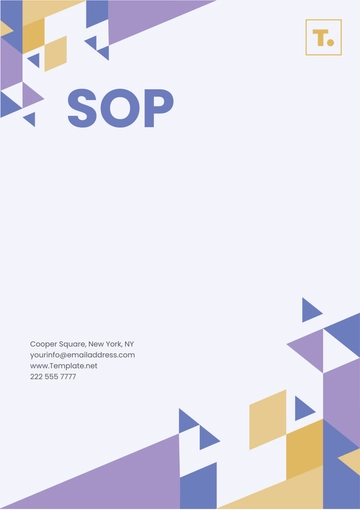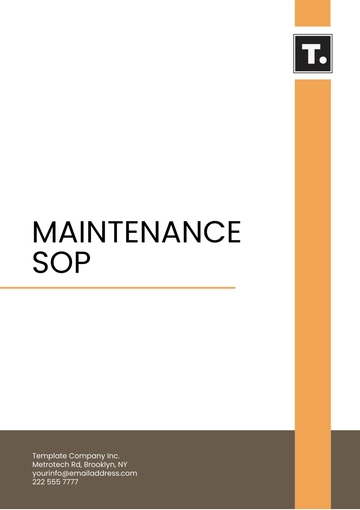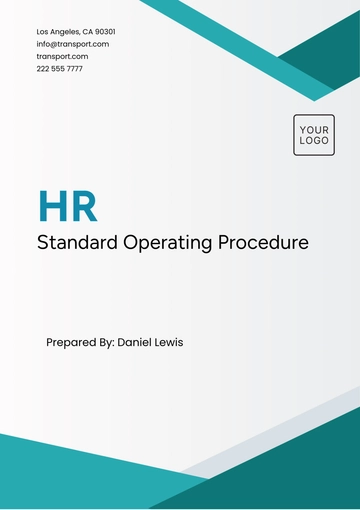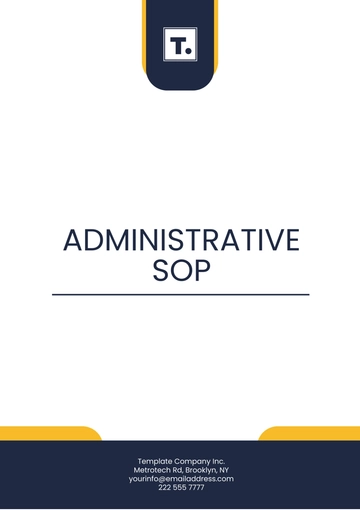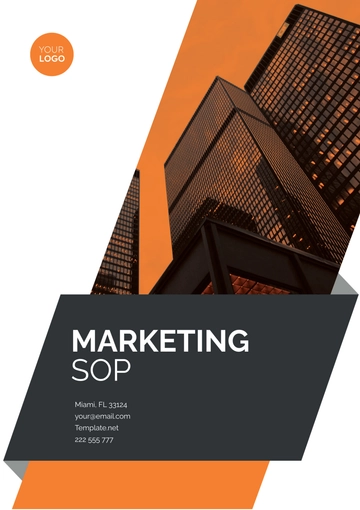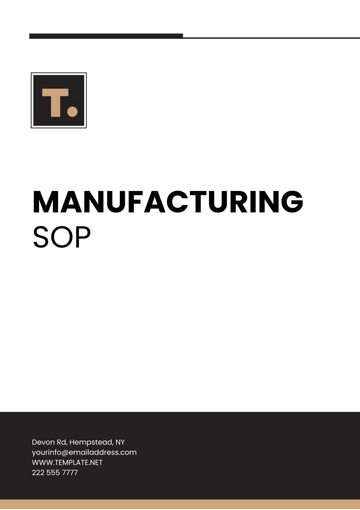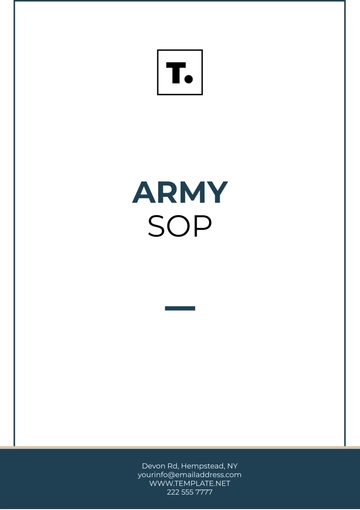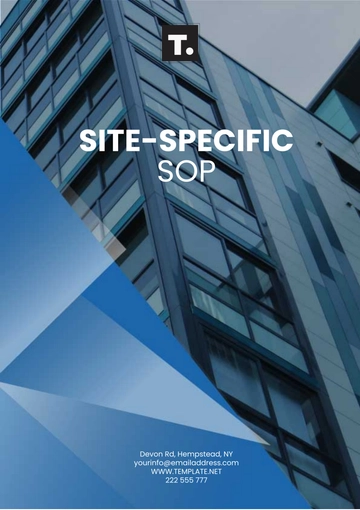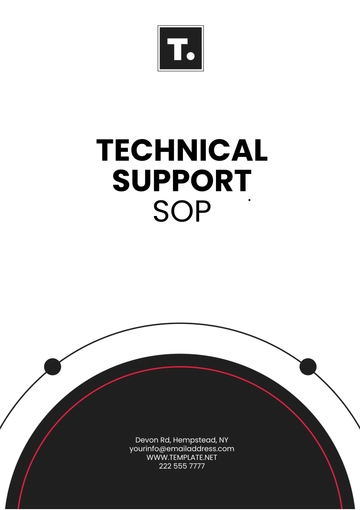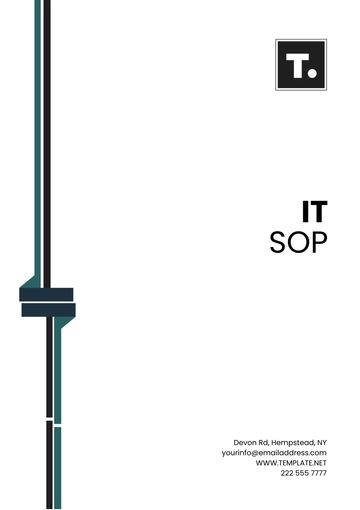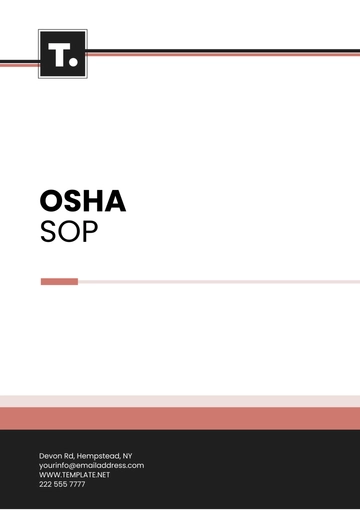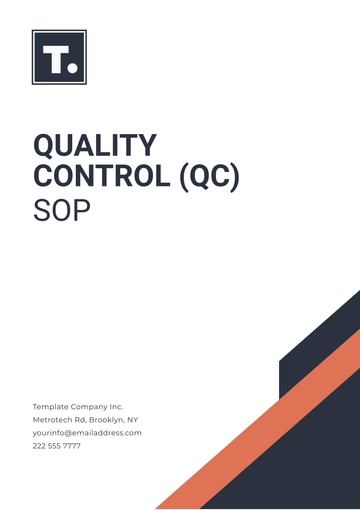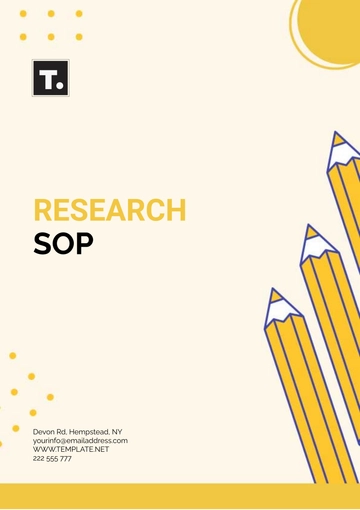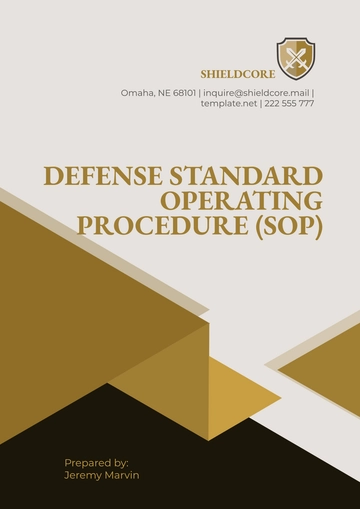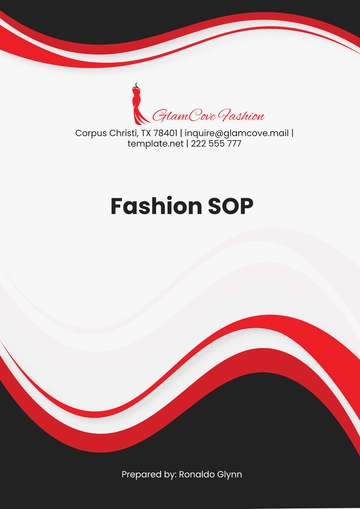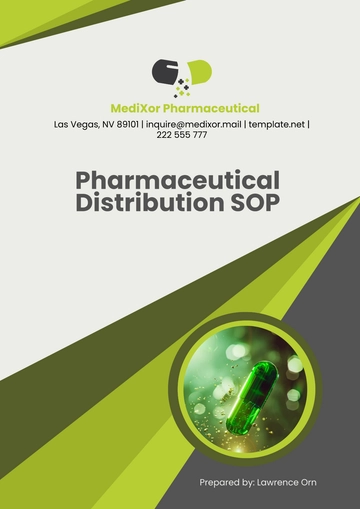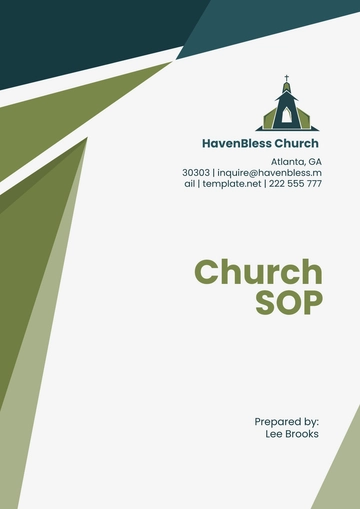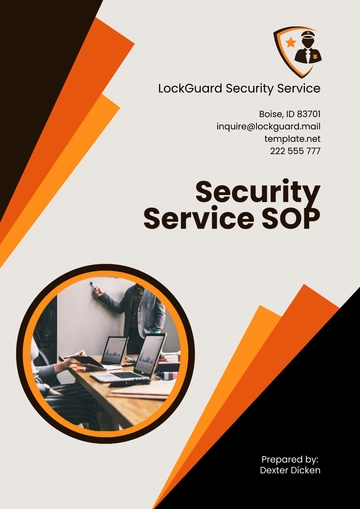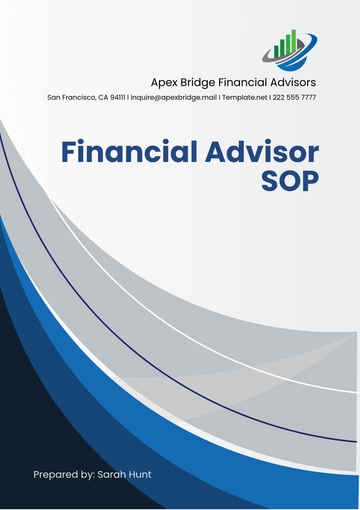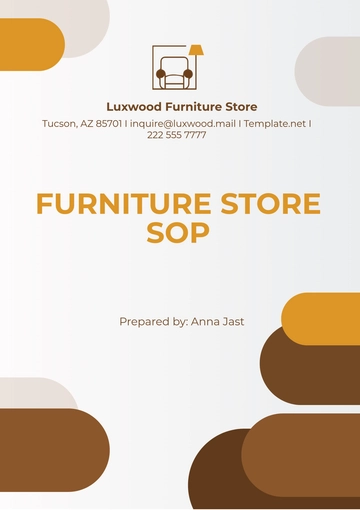Free Grocery Store Supplier Management SOP

I. Introduction
A. Purpose
The purpose of this Grocery Store Supplier Management SOP is to establish clear procedures and guidelines for managing supplier relationships at [Your Company Name]. Effective supplier management is critical to ensuring the quality, availability, and cost-effectiveness of the products we offer to our customers.
B. Scope
This SOP covers all aspects of supplier management, including selection, evaluation, communication, performance monitoring, and issue resolution. It applies to all employees involved in the procurement and supplier management process.
C. Target Audience
This SOP is intended for use by procurement staff, store managers, and anyone involved in supplier interactions at [Your Company Name].
D. Key Definitions
Supplier: Any entity that provides goods or services to [Your Company Name].
Procurement: The process of sourcing and acquiring goods and services from suppliers.
Quality Assurance: Ensuring that the products supplied meet the company's standards and specifications.
II. Supplier Selection
The following table outlines the steps involved in the supplier selection process:
No. | Step | Description |
|---|---|---|
1 | Identify Needs | Determine the products or services needed. |
2 | Market Research | Research potential suppliers. |
3 | Request for Proposal | Solicit proposals from shortlisted suppliers. |
4 | Evaluation | Assess the proposals based on set criteria. |
5 | Selection | Choose the best supplier based on evaluation. |
A. Identify Needs
Define Requirements: Clearly define the product or service requirements. This includes specifications, quality standards, and delivery expectations. Clear requirements help ensure that the selected supplier can meet our needs.
Volume Estimation: Estimate the required volume for the product or service. Accurate volume estimation is crucial for ensuring supply continuity and negotiating favorable terms.
Budgeting: Establish a budget for the procurement. Budgeting helps manage costs and ensures that expenditures align with financial goals.
B. Market Research
Supplier Search: Conduct a thorough search for potential suppliers. Use various sources such as industry directories, online databases, and trade shows. A comprehensive search increases the chances of finding suitable suppliers.
Supplier Screening: Screen suppliers based on initial criteria such as product quality, reputation, and financial stability. Initial screening helps narrow down the list of potential suppliers to those most likely to meet our needs.
Preliminary Contact: Make preliminary contact with potential suppliers to gather more information. This step helps assess the supplier's responsiveness and willingness to engage.
C. Request for Proposal
Prepare RFP: Prepare a detailed Request for Proposal (RFP) document. The RFP should outline the requirements, evaluation criteria, and submission guidelines. A clear RFP helps ensure that proposals are complete and comparable.
Distribute RFP: Distribute the RFP to the shortlisted suppliers. Distribution can be done via email, online portals, or physical mail. Ensuring timely distribution allows suppliers sufficient time to prepare their proposals.
Clarifications: Provide a period for suppliers to ask questions and seek clarifications. Addressing questions ensures that proposals are based on a clear understanding of our needs.
D. Evaluation
Proposal Review: Review the received proposals against the evaluation criteria. A systematic review process helps ensure fair and objective assessment.
Scoring: Score each proposal based on criteria such as price, quality, and delivery terms. Scoring provides a quantifiable basis for comparison.
Shortlisting: Shortlist the top proposals for further consideration. Shortlisting focuses the selection process on the most promising options.
E. Selection
Final Evaluation: Conduct a final evaluation of the shortlisted proposals. This may include additional discussions, site visits, or sample testing. Final evaluation helps verify the suitability of the supplier.
Decision Making: Make the final supplier selection decision based on the evaluation results. Decision making should involve key stakeholders to ensure alignment and buy-in.
Contract Negotiation: Negotiate the contract terms with the selected supplier. Effective negotiation helps secure favorable terms and establish a strong foundation for the relationship.
III. Supplier Evaluation
The following table outlines the key criteria used for evaluating suppliers:
No. | Criteria | Description |
|---|---|---|
1 | Quality | Assess the quality of supplied products. |
2 | Delivery Performance | Evaluate the timeliness of deliveries. |
3 | Cost | Analyze the cost competitiveness. |
4 | Responsiveness | Measure the supplier's responsiveness. |
5 | Compliance | Check compliance with agreements and regulations. |
A. Quality
Product Inspection: Regularly inspect the products received from suppliers. Inspections help ensure that the products meet our quality standards. They also provide a basis for addressing any quality issues.
Quality Reports: Require suppliers to provide regular quality reports. Reports should include test results, defect rates, and corrective actions. Regular reporting helps monitor quality trends and identify issues early.
Supplier Audits: Conduct periodic audits of the supplier's facilities and processes. Audits provide an in-depth assessment of the supplier's quality management systems.
B. Delivery Performance
On-Time Delivery Rate: Track the on-time delivery rate for each supplier. On-time delivery is crucial for maintaining inventory levels and meeting customer demands. It reflects the supplier's reliability and efficiency.
Lead Time: Monitor the lead time for orders. Short and consistent lead times help ensure supply continuity and reduce inventory costs.
Order Accuracy: Check the accuracy of delivered orders. Accurate deliveries reduce the need for returns and rework, saving time and costs.
C. Cost
Price Competitiveness: Compare the supplier's prices with market rates. Competitive pricing helps manage procurement costs and improve profitability.
Total Cost of Ownership: Consider the total cost of ownership, including shipping, handling, and maintenance costs. Total cost analysis provides a more comprehensive view of the cost impact.
Cost Reduction Opportunities: Identify opportunities for cost reduction with the supplier. Collaborative efforts can lead to mutually beneficial cost savings.
D. Responsiveness
Communication: Evaluate the supplier's communication effectiveness. Timely and clear communication is essential for addressing issues and coordinating activities.
Problem Resolution: Assess the supplier's ability to resolve problems quickly and effectively. Effective problem resolution helps minimize disruptions and maintain smooth operations.
Flexibility: Measure the supplier's flexibility in accommodating changes in orders or schedules. Flexibility is important for adapting to changing business needs.
E. Compliance
Contract Compliance: Check the supplier's compliance with contractual terms and conditions. Compliance ensures that the supplier meets agreed-upon obligations.
Regulatory Compliance: Verify that the supplier complies with relevant laws and regulations. Regulatory compliance helps avoid legal issues and ensure ethical practices.
Sustainability: Assess the supplier's sustainability practices. Sustainable practices contribute to our corporate social responsibility goals and enhance our brand reputation.
IV. Communication and Relationship Management
The following table outlines key communication strategies and relationship management practices:
No. | Strategy | Description |
|---|---|---|
1 | Regular Meetings | Schedule regular meetings with suppliers. |
2 | Performance Reviews | Conduct periodic performance reviews. |
3 | Issue Resolution | Establish clear issue resolution processes. |
4 | Collaboration | Foster collaboration and partnership. |
5 | Feedback Loop | Maintain an open feedback loop. |
A. Regular Meetings
Schedule Meetings: Schedule regular meetings with key suppliers. Meetings provide an opportunity to discuss performance, address issues, and plan for future needs.
Agenda Setting: Set clear agendas for each meeting. Agendas help ensure that meetings are productive and focused on key topics.
Follow-Up Actions: Document follow-up actions and responsibilities. Clear follow-up ensures that issues are addressed and progress is made.
B. Performance Reviews
Review Frequency: Conduct performance reviews on a regular basis. Regular reviews help monitor supplier performance and identify trends.
Review Criteria: Use established criteria for performance reviews. Consistent criteria ensure fair and objective assessments.
Feedback Sharing: Share review results with the supplier. Transparent feedback helps suppliers understand our expectations and areas for improvement.
C. Issue Resolution
Issue Logging: Log all supplier-related issues. A clear log helps track issues and their resolutions.
Root Cause Analysis: Conduct root cause analysis for recurring issues. Understanding the root cause helps implement effective solutions.
Corrective Actions: Develop and implement corrective actions. Effective corrective actions help prevent recurrence of issues.
D. Collaboration
Joint Projects: Engage in joint projects with key suppliers. Collaborative projects foster innovation and mutual benefits.
Training and Development: Provide training and development opportunities for suppliers. Training helps suppliers improve their capabilities and performance.
Information Sharing: Share relevant information with suppliers. Information sharing enhances transparency and coordination.
E. Feedback Loop
Feedback Channels: Establish clear channels for supplier feedback. Open feedback channels encourage suppliers to share their perspectives and suggestions.
Feedback Analysis: Regularly analyze feedback from suppliers. Analysis helps identify common themes and areas for improvement.
Actionable Insights: Use feedback to develop actionable insights. Implementing insights helps improve supplier relationships and performance.
V. Contract Management
The following table outlines key contract management activities:
No. | Activity | Description |
|---|---|---|
1 | Contract Drafting | Draft and review supplier contracts. |
2 | Contract Approval | Obtain necessary approvals for contracts. |
3 | Contract Execution | Ensure proper execution of contracts. |
4 | Contract Monitoring | Monitor compliance with contract terms. |
5 | Contract Renewal | Manage contract renewals and expirations. |
A. Contract Drafting
Drafting Templates: Use standardized templates for drafting contracts. Templates ensure consistency and completeness of contracts.
Legal Review: Conduct a legal review of draft contracts. Legal review helps identify and mitigate potential risks.
Stakeholder Input: Incorporate input from relevant stakeholders. Stakeholder input ensures that contracts meet business needs and address potential issues.
B. Contract Approval
Approval Process: Establish a clear approval process for contracts. A defined process helps ensure timely and thorough review.
Approval Authorities: Identify the appropriate approval authorities. Clear authorities ensure that contracts are approved by the right individuals.
Documentation: Document the approval process and decisions. Documentation provides a record of the approval process and supports compliance.
C. Contract Execution
Signature Process: Follow a standardized process for obtaining signatures. A clear process helps ensure that contracts are properly executed.
Execution Records: Maintain records of executed contracts. Records provide a reference for contract terms and support compliance.
Distribution: Distribute copies of executed contracts to relevant parties. Distribution ensures that all parties are aware of their obligations.
D. Contract Monitoring
Compliance Checks: Conduct regular compliance checks against contract terms. Compliance checks help ensure that suppliers meet their obligations.
Performance Tracking: Track supplier performance against contract metrics. Performance tracking helps identify issues and areas for improvement.
Issue Resolution: Address any issues related to contract compliance. Prompt issue resolution helps maintain contract integrity.
E. Contract Renewal
Renewal Process: Establish a process for managing contract renewals. A clear process helps ensure timely and smooth renewals.
Expiry Monitoring: Monitor contract expiry dates. Monitoring helps prevent lapses in coverage and ensures continuity.
Negotiation: Negotiate renewal terms as needed. Effective negotiation helps secure favorable terms and maintain strong relationships.
VI. Performance Monitoring
The following table outlines the steps involved in performance monitoring:
No. | Step | Description |
|---|---|---|
1 | Define Metrics | Establish performance metrics. |
2 | Data Collection | Collect performance data. |
3 | Data Analysis | Analyze performance data. |
4 | Reporting | Report performance results. |
5 | Continuous Improvement | Implement improvements based on findings. |
A. Define Metrics
Key Metrics: Identify key performance metrics relevant to supplier performance. Metrics should align with business goals and supplier agreements.
Benchmarking: Benchmark metrics against industry standards. Benchmarking provides a basis for comparison and goal setting.
Metric Review: Regularly review and update metrics as needed. Regular review ensures that metrics remain relevant and effective.
B. Data Collection
Data Sources: Identify reliable sources of performance data. Data sources may include internal records, supplier reports, and third-party assessments.
Data Accuracy: Ensure the accuracy and reliability of collected data. Accurate data is essential for meaningful analysis and decision making.
Data Frequency: Determine the frequency of data collection. Regular data collection supports timely monitoring and responsiveness.
C. Data Analysis
Trend Analysis: Analyze performance trends over time. Trend analysis helps identify patterns and areas for improvement.
Root Cause Analysis: Conduct root cause analysis for performance issues. Understanding root causes helps develop effective solutions.
Comparative Analysis: Compare performance across suppliers. Comparative analysis helps identify best practices and areas for improvement.
D. Reporting
Report Format: Develop a standardized format for performance reports. Standardized reports ensure consistency and clarity.
Audience: Tailor reports to the intended audience. Different stakeholders may require different levels of detail and focus.
Actionable Insights: Include actionable insights in reports. Insights should provide clear recommendations for improvement.
E. Continuous Improvement
Improvement Plans: Develop improvement plans based on performance findings. Improvement plans should include specific actions and timelines.
Implementation: Implement improvement plans with supplier collaboration. Collaboration ensures that improvements are practical and sustainable.
Monitoring Progress: Monitor progress against improvement plans. Regular monitoring helps ensure that improvements are on track and effective.
VII. Issue Resolution
The following table outlines the steps involved in issue resolution:
No. | Step | Description |
|---|---|---|
1 | Issue Identification | Identify the issue. |
2 | Issue Logging | Log the issue in a tracking system. |
3 | Root Cause Analysis | Analyze the root cause of the issue. |
4 | Corrective Actions | Develop corrective actions. |
5 | Follow-Up | Follow up to ensure issue resolution. |
A. Issue Identification
Incident Reporting: Encourage staff to report supplier-related incidents promptly. Timely reporting helps address issues before they escalate.
Initial Assessment: Conduct an initial assessment of the issue. Initial assessment helps determine the severity and potential impact.
Stakeholder Notification: Notify relevant stakeholders about the issue. Notification ensures that all impacted parties are aware and involved in resolution.
B. Issue Logging
Tracking System: Use a centralized system to log issues. A centralized system helps track issues and their resolution status.
Detailed Logging: Log detailed information about the issue. Detailed logs provide a clear record for analysis and follow-up.
Issue Categorization: Categorize issues based on type and severity. Categorization helps prioritize issues and allocate resources effectively.
C. Root Cause Analysis
Investigation: Conduct a thorough investigation to identify the root cause. Investigation should involve relevant stakeholders and experts.
Analysis Tools: Use appropriate tools and techniques for root cause analysis. Tools may include fishbone diagrams, 5 Whys, and failure mode analysis.
Documentation: Document the findings of the root cause analysis. Documentation provides a reference for developing corrective actions.
D. Corrective Actions
Action Plan: Develop a detailed action plan to address the root cause. Action plans should include specific steps, responsible parties, and timelines.
Implementation: Implement corrective actions with supplier collaboration. Collaboration ensures that actions are feasible and supported.
Verification: Verify the effectiveness of corrective actions. Verification helps ensure that actions have resolved the issue and prevented recurrence.
E. Follow-Up
Monitoring: Monitor the situation to ensure that the issue has been fully resolved. Monitoring helps identify any residual issues or related problems.
Feedback: Provide feedback to suppliers on issue resolution. Feedback helps improve supplier performance and relationships.
Continuous Improvement: Use the issue resolution process to identify opportunities for continuous improvement. Continuous improvement helps prevent future issues and enhance supplier management.
VIII. Documentation and Record Keeping
The following table outlines key documentation and record-keeping activities:
No. | Activity | Description |
|---|---|---|
1 | Contract Records | Maintain records of all supplier contracts. |
2 | Performance Records | Keep detailed records of supplier performance. |
3 | Communication Records | Document all communication with suppliers. |
4 | Issue Records | Log all supplier-related issues and resolutions. |
5 | Audit Records | Keep records of all supplier audits. |
A. Contract Records
Centralized Storage: Store all supplier contracts in a centralized location. Centralized storage ensures easy access and retrieval.
Electronic Copies: Maintain electronic copies of contracts. Electronic copies provide backup and facilitate sharing.
Access Control: Implement access control measures to protect sensitive contract information. Access control helps maintain confidentiality and compliance.
B. Performance Records
Performance Metrics: Maintain records of key performance metrics for each supplier. Performance records provide a basis for evaluation and improvement.
Reporting Frequency: Establish a reporting frequency for performance records. Regular reporting helps ensure timely review and action.
Retention Policy: Implement a retention policy for performance records. Retention policies ensure compliance with legal and regulatory requirements.
C. Communication Records
Documentation Format: Use a standardized format for documenting supplier communications. Standardized formats ensure clarity and consistency.
Retention Duration: Determine the retention duration for communication records. Retention duration should align with legal requirements and business needs.
Accessibility: Ensure that communication records are easily accessible to relevant stakeholders. Accessibility supports transparency and accountability.
D. Issue Records
Issue Log: Maintain a centralized log of all supplier-related issues. A centralized log provides a comprehensive view of issues and resolutions.
Resolution Documentation: Document the resolution process for each issue. Documentation provides a reference for future issues and improves the resolution process.
Periodic Review: Conduct periodic reviews of issue records. Periodic reviews help identify trends and opportunities for improvement.
E. Audit Records
Audit Documentation: Maintain detailed documentation of all supplier audits. Audit documentation provides a basis for evaluation and compliance.
Audit Findings: Document findings and recommendations from audits. Findings and recommendations help drive improvements and corrective actions.
Follow-Up Actions: Track follow-up actions resulting from audit findings. Tracking follow-up actions ensures accountability and progress.
IX. Review and Update
This Grocery Store Supplier Management SOP will be reviewed annually or as needed to ensure its relevance and effectiveness. Regular review helps identify areas for improvement and updates based on changing business needs or market conditions.
A. Review Process
Designated Review Team: Establish a designated team responsible for reviewing the SOP. A dedicated team ensures thorough and unbiased review.
Feedback Collection: Collect feedback from stakeholders on the SOP's effectiveness. Feedback provides insights for potential updates and improvements.
Revision Recommendations: Develop recommendations for revisions based on the review process. Recommendations should be based on data and stakeholder input.
B. Update Implementation
Approval for Changes: Obtain necessary approvals for any proposed changes to the SOP. Approval ensures that changes are supported by management.
Communication of Updates: Communicate updates to all relevant staff. Clear communication helps ensure that everyone is aware of changes and new procedures.
Training: Provide training on any significant updates to the SOP. Training helps ensure that staff understand and can implement changes effectively.
C. Record Keeping
Version Control: Implement version control for the SOP. Version control helps track changes and maintain an accurate history of the document.
Documentation of Updates: Document all updates and revisions made to the SOP. Documentation provides a record of changes and the rationale behind them.
Accessibility: Ensure that the most current version of the SOP is easily accessible to all relevant staff. Accessibility supports compliance and effective implementation.
Regular review and updates of the SOP are crucial for ensuring its continued relevance and effectiveness in managing supplier relationships at [Your Company Name]. By following these processes, we can adapt to changing circumstances and maintain strong supplier partnerships.
- 100% Customizable, free editor
- Access 1 Million+ Templates, photo’s & graphics
- Download or share as a template
- Click and replace photos, graphics, text, backgrounds
- Resize, crop, AI write & more
- Access advanced editor
Improve supplier relationships with the Grocery Store Supplier Management SOP Template! Available on Template.net, this template is fully editable, allowing you to tailor your SOPs to your needs. It’s also customizable, so you can adjust the format and content as necessary. The integrated AI Editor Tool ensures easier SOP generation!



